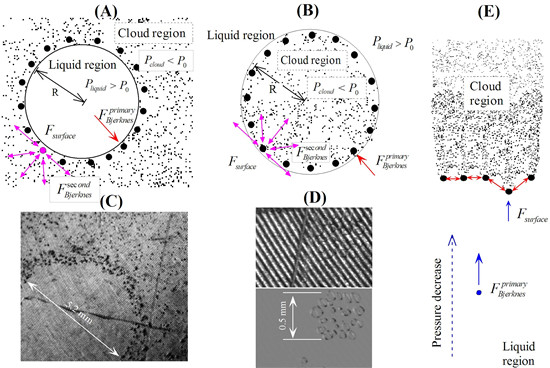Cavitaion refers to the formation and subsequent dynamic life of bubbles in liquids subjected to a sufficiently low pressure. The high-energy concentration and the mechanical, optical, acoustical, and chemical effects of cavitation have attracted multitudinous scientists’ attentions and research interests.
Recently, researchers BAI Lixin, LIN Weijun, WU Pengfei et al. from the Institute of Acoustics of the Chinese Academy of Sciences investigate the cavitation structures in a thin liquid layer. They discover that the cavitation bubble cloud between the two parallel solid walls show some new characteristics (quasi-emulsion phenomenon and surface tension) because of the two-dimensional nature of thin liquid layer, and the bubble cloud can be regarded as a new-typed colloidal system. As far as it is known, this is the first analysis of surface tension and quasi-emulsion of cavitation bubble cloud. It provides a new perspective for cavitation research.

Fig.1 The surface tension of cavitation bubble cloud. (A) and (C) A disc-shaped liquid region (f = 20 kHz, h = 0.82 mm). (B) and (D) A disc-shaped cloud region (f = 20 kHz, h < 100 lm). (E) The forces exerted on the cavitation bubbles on the interface (Image by BAI Lixin et al.)
In an emulsion, one liquid (the dispersed phase) is dispersed in the other (the continuous phase). With the increase of cavitation cloud, the cavitation structures transform form cloud-in-water (c/w) emulsion to water-in-cloud (w/c) emulsion. The phase inversion is related to the volume of cavitation bubble cloud. When there are not enough bubbles, the cavitation bubble clouds are small and isolated, and have no chance to merge with each other (c/w emulsion). When there are enough bubbles, these bubble clouds will spread and cross-link with each other and form w/c emulsion.
The cloud region (cavitation region) is formed by numerous cavitation bubbles. The acoustic intensity is weakened by the absorption and scattering of bubbles. As a result, the acoustic pressure in the liquid region (water without bubbles) is much higher than that in the cloud region. When the pressure amplitude in the liquid region exceeds a threshold value, cavitation bubbles tend to move along the direction of pressure drop. The bubbles are pushed from liquid region to cloud region by the primary Bjerknes forces. Because there are no bubbles in the liquid region, the ultrasound will be reflected and superimposed between two solid walls. As a result, the cloud region and liquid region will remain stable for a long period (tens of milliseconds to seconds).
Curved boundaries between the liquid region and cloud region is a very stable structure - so stable, in fact, that it is the final form of the structure evolution. In order to investigate the relationship between the motion and curvature of interface, a circular shape factor (CSF) is defined to represent the degree of deviation from the circular shape. It is found that rate of change of CSF increase with the increase of CSF, which is the same with the deformation of bubbles in water under the action of surface tension. So it is considered that a kind of surface tension (the elastic tendency of a cavitation bubble cloud surface which makes it acquire the least surface area possible) may exist on the interface between cloud region and liquid region. The experiments prove the existence of surface tension in the system.
Funding for this research came from the National Natural Science Foundation of China (No. 11674350) and the National Basic Research Program of China (No. 2013CB035905).
Reference:
BAI Lixin, CHEN Xiaoguang, ZHU Gang, XU Weilin, LIN Weijun, WU Pengfei, LI Chao, XU Delong, YAN Jiuchun. Surface Tension and Quasi-emulsion of Cavitation Bubble Cloud. Ultrasonics Sonochemistry (Volume 35, Part A, March 2017, Pages 405–414). DOI: 10.1016/j.ultsonch.2016.10.019
Contact:
BAI Lixin
Research Center for Ultrasonics and Technologies, Institute of Acoustics, Chinese Academy of Sciences, 100190 Beijing, China
E-mail: blx@mail.ioa.ac.cn


